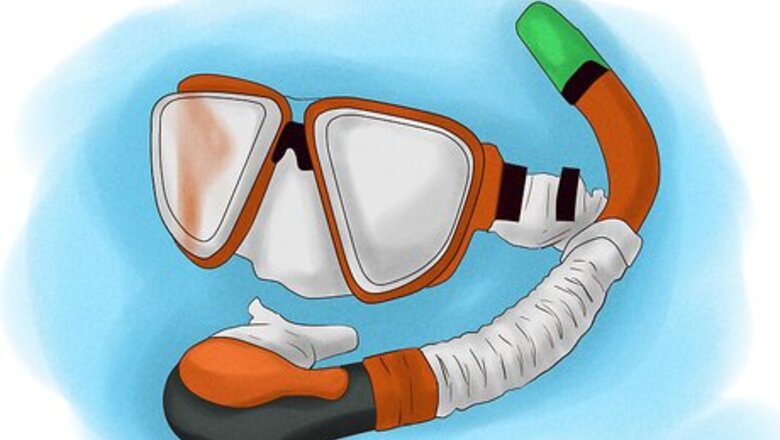
views
- Try on different sized snorkels and masks to find one that feels comfortable. Then, pull on the adjustable mask straps until it is sealed around your eyes and nose.
- Get in the water, lay flat on your stomach, and bite down on the snorkel. Take slow, deep breaths through the snorkel to get used to it and relax.
- After you dive underwater, clear the water in the snorkel by surfacing and exhaling forcefully into the mouthpiece.
Getting Started
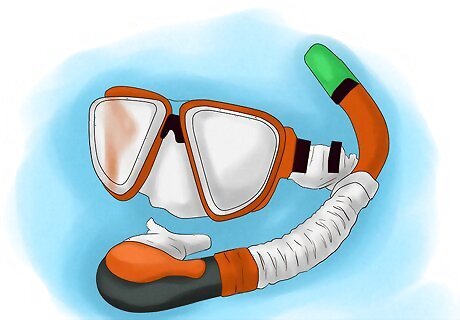
Get a snorkel and mask you feel comfortable with. Try them on and adjust the straps until it fits. If you can, try them on in the water to make sure there are no leaks. If you have bad eyesight, consider getting a prescription-adjusted mask to help you see underwater without your glasses or using contact lenses. Disposable ones are great for snorkelling in.
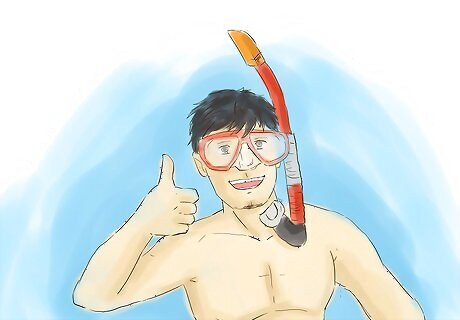
Put on the mask and tug the straps until it feels comfortably sealed around your eyes and nose. Make sure the snorkel tube is close to your mouth, but don't put it in yet.

Lay flat in the water on your stomach. Place your face in the water at about a 45 degree angle.
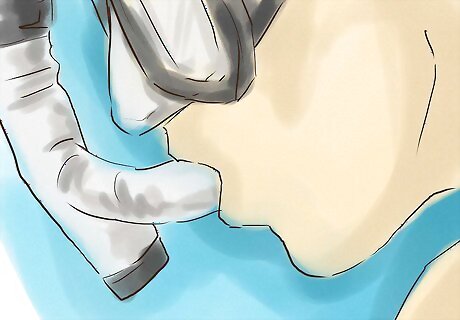
Bite gently down on the mouthpiece of the snorkel. Allow your lips to seal around it and hold the snorkel in place.
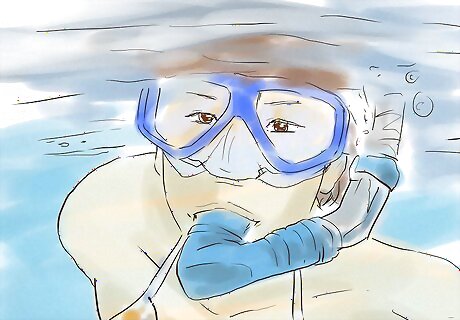
Take slow, regular breaths in and out through the tube. Breathe slowly, deeply and cautiously with your mouth through your snorkel. No need to panic: you can always lift your head above water if you want. Just relax and become aware of your breaths. The sound of your breathing through the snorkel barrel should become quite noticeable. Once you get into a rhythm, relax and enjoy the underwater scenery.

Wear a buoyancy vest. This makes floating on the surface of the water with minimal effort much easier. Many commercial snorkeling locations require a colorful life vest to be worn for safety reasons.
Learning to Keep Your Airway Clear
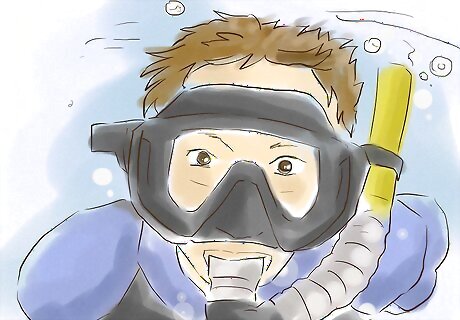
Breathe cautiously. On any snorkeling adventure you are bound to get some water in your tube at some point, sometimes either due to surf conditions or excessive splashing, or by letting your head dip too low in the water. Learning to clear your snorkel will keep this from being a cumbersome disruption to your experience.

Hold your breath and place your head below the water, submerging the end of the snorkel. You should feel that water is entering the snorkel barrel.

Surface your head without lifting it out of the water. Make sure the end of the tube is in the air this time.

Exhale through your mouth quickly and forcefully into the snorkel. This blast method of snorkel clearing will remove nearly all the water from your snorkel.

Expel any remaining amount of water with a second forceful blast. By repeating the blast method you should clear any water that enters into the snorkel.

Master airway control. Sometimes you will get water in your tube when you have no air in your lungs. If there is only a little water, inhale slowly and carefully without letting water into your mouth until you have enough air for a full blast. If there is too much, you will need to lift your head out of the water and take a breath around the mouthpiece.
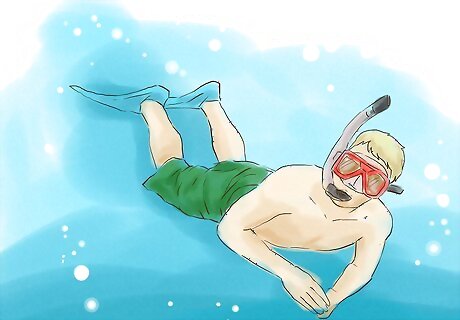
Learn to dive. Once you get adept at clearing your airway, you can consider diving below the surface of the water to get a better look at something nifty. Take a deep breath and swim down. When you need a breath, surface, keeping your face underwater, and clear your flooded snorkel tube like you practiced.
Swimming with a Snorkel
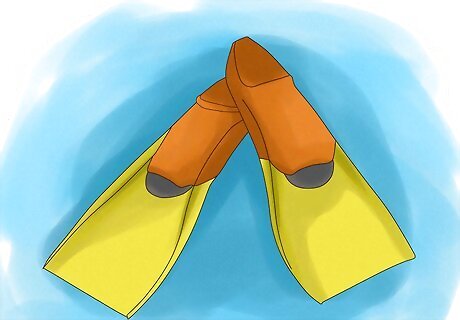
Use fins on your feet. Wearing fins will amplify your movements and let you move forward quickly without a lot of disruptive splashing.
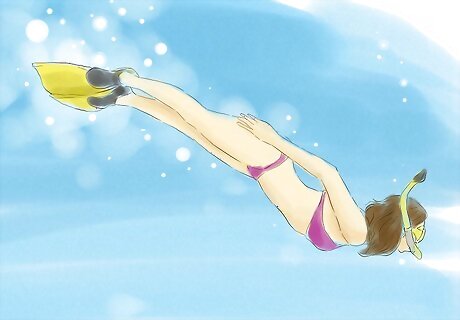
Hold your arms at your sides to reduce drag and extend your legs so that the fins are pointed behind you. Keep your legs fairly close together.

With your knees slightly bent, kick slowly and powerfully with the fins. Keep your fin stroke movements smooth and relaxed. Try to move from the hip to make use of your thigh muscles and avoid kicking with your knees, as this will only waste your energy.
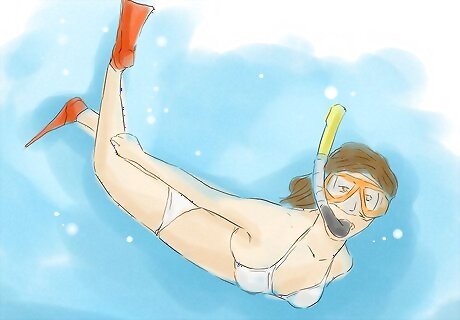
Kick farther down and less upwards whilst arching your back upward. The right snorkeling technique to power yourself forward with the downward strokes.

Keep your fins below the water when kicking. Try to avoid splashing, as this will scare off the fish and can be annoying to other swimmers around you.
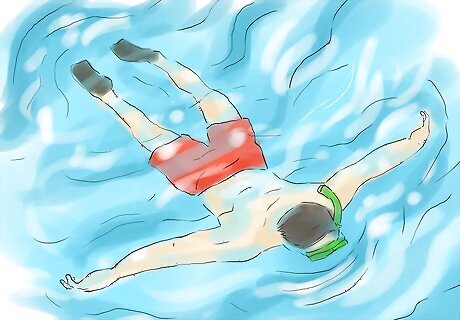
Float with the waves. Snorkeling is best done on gentle waters, but even there you should learn to adjust your movements to the up and down surging of the waves.
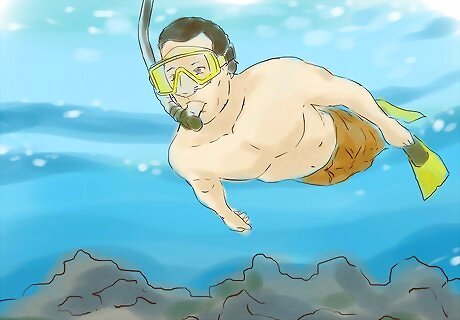
Swim at a steady comfortable pace to conserve your energy. Snorkeling is not a race, and a good session can last for hours.
Having a Good Snorkel Experience

Pick the right spot. You want to snorkel in an area that has relatively calm waters and a vibrant mix of benign marine life. Shallow waters above coral reefs are great, as are some deeper spots best accessed by boat. Ask locals or check guidebooks to find the best spots that aren't too full of other swimmers. Learn proper tube clearing technique. "I had snorkeled in the Maldives before, but I still struggled with knowing how to clear water out of my snorkel tube. The step-by-step instructions and images on how to hold your breath, submerge the tube, surface, and forcefully exhale were extremely helpful. Now, I feel confident in my ability to keep my airway clear during any future snorkeling adventures." - Helen R. Pick ideal weather and location conditions. "I appreciated the tips on when and where to go snorkeling. I live in the Keys of Florida and wanted to try it along the beach coast before dropping cash on a boat ride out to the reefs. The advice to go on a sunny day and pick a spot with calm shallow waters really helped me have a great first experience right from shore." - Deb S. Gain basic snorkeling competency. "The article gave me a good general overview that made me aware of how to prepare with the right gear, relax and breathe through the tube, clear the tube of water, and swim smoothly. As a beginner, this brief introduction covered everything I needed to know to feel comfortable trying snorkeling for the first time." - Editha M. Did you know that wikiHow has collected over 365,000 reader stories since it started in 2005? We’d love to hear from you! Share your story here.
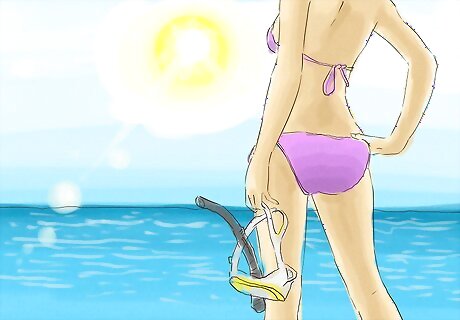
Go out on a sunny day. Even with a mask it's hard to see much underwater if the sky is dark and gloomy. Snorkel in the middle of a bright day when the water is clear of silt. Storms tend to churn up silt that clouds the water, so if it rained last night you may want to put your adventure off by a day.

Learn to recognize different fish and coral. Seen one fish, seen them all? Not if you know what you are looking at. Memorize the shapes and colors of different kinds of fish that inhabit your local beaches and you can turn your simple swim into an aquatic zoological survey. If you see a fish you don't recognize, try to remember its patterns and look it up later.

















Comments
0 comment